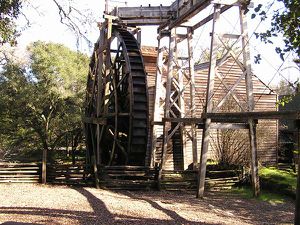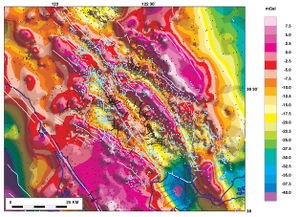Geology and Ground Water Conditions in Napa County

By E.H. Boudreau
Registered Geologist #3000
Introduction
Ground water is not evenly distributed throughout Napa County, and this is because the geologic conditions are not uniform. To get a successful! well, it is necessary to drill into permeable rock below the water table. Some types of rock are naturally permeable, some are naturally impermeable, and some may or may not be permeable (depending on what has happened to them). From this, it follows that the better the geologic conditions (rocktypes, faults, etc.) under a property are known, the better the chance of finding the water that is wanted, provided it is there.
General geology of Napa County
Different geologic Processes occurring over many millions of years have resulted in the variety of rocktypes that underlie the county, as well as the sculpture of the landscape. The county has been below sea level, covered by volcanic rocks, broken and shifted by stresses in the earth's crust (as expressed by faulting and folding), carved by erosion, 5 and filled by sedimentation.
Consolidated Marine Rocks
Most of the very oldest rocks are marine sediments that were deposited on the floor of the ocean from about 20 million to 140 million years ago when all of the county lay below sea level. Thousands of feet of lenses or beds of clay, sand, and gravel built up and gradually compacted and hardened into what are now called shale, sandstone, and conglomerate.
Shale (compacted clay) is a gray, weak, crumbly rock, while sandstone (cemented sand) and conglomerate (cemented gravel) are very hard rocks. Besides the sediments, there are some sub-marine lavaflows (called "greenstone" because of their color) and beds of chert (sedimentary silica) which are also very hard rocks. These ancient marine rocks constitute the great bulk of the rock under the county, as can be seen on the geologic map and cross section accompanying this article.
The above-mentioned rocks are divided into different groups, called "formations." There are the Knoxville Formation (first studied around the town of Knoxville), the Franciscan Formation (first studied on the San Francisco Peninsula), the Great Valley Formation (first studied on the west edge of the Sacramento Valley, and many others.
Serpentine
Another ancient rock is serpentine, blue-green in color and having a greasy luster. This rock was squeezed up through the earth's crust along fault zones, becoming highly sheared and broken in the process. (Usually, very little vegetation grows on serpentine.)
The Sonoma Volcanics
About 10 million years ago, when most of the county was above sea level, a long period of volcanic activity began. (Contrary to popular belief, Mount St. Helena was never a volcano.) The series of lavaflows and beds of tuff (volcanic ash) is called the Sonoma Volcanics (having first been studied around the town of Sonoma, and these rocks cover much of western Napa County. There are also some stream and lake sediments included in the volcanics. (The so-called "limestone caves" of a winery north of St. Helena are actually in a white tuff.) Although erosion has removed the volcanics in many areas, reexposing the underlying consolidated marine sediments, the volcanics are still as much as a couple of thousand feet thick in places.
Glen Ellen Formation & Alluvium
Over the past three million years, following the end of the volcanic episode, the valleys have been partially filled with beds of clay, sand, and gravel which are only loosely consolidated. These rocks are called the Glen Ellen Formation (for exposures around Glen Ellen), and Alluvium; the Alluvium beds are the youngest and least consolidated in the series. Their combined thickness can be as much as a thousand feet. Sand and gravel are stream channel deposits that formed where water action was strong, while clay settled out in lakes and floodplains where quiet water conditions prevailed. These rocks are most prevalent and thickest under the Napa Valley and the Carneros area.
Geologic Structure
During and following their formation, the rock units were more or less deformed and broken during periods of folding and faulting caused by stresses in the earth's crust. Folding is tilting of the layers of rock, A fault is a fracture in the rock along which there has been movement, and the direction of movement of the opposite blocks of rock can be anywhere from vertical to lateral. (The Geological Survey has credited me with the discovery - based on information developed by well drilling - of an important fault that runs along the west side of the Napa Valley for at least twenty miles.)
General ground water potential
All the fresh ground water under the county comes from local rainfall and streamflow that percolates down into the ground, and it exists in small pore spaces and fractures (usually only a small fraction of an inch in size) in the zone of water-saturated rock below the water table. (As explained in my previous article on the fallacy of water witching, there are no underground streams or lakes, and the water does not come from the Sierra Nevada - or Mount Shasta.) Movement of the water, which is percolating very slowly, is from the ridges down towards the valleys, and in a down-valley direction. Depth to the water table varies according to the geology, hydrology, and topography of an area, but it tends to be greatest under the boldest terrain features and the least under valleys. (Anywhere from less than a foot to over 1,000 feet.) Seasonal fluctuation in the water table can be from zero to several tens of feet, with the table being highest in the spring and lowest in the fall.
Water in Consolidated Rocks

Consolidated rocks depend mainly on small, open fractures to provide them with the needed open area necessary to store and transmit water in usable amounts. But only very hard consolidated rocks have the strength required to hold fractures open under the pressure of the rock above. Such potentially permeable consolidated rocks are sandstone, conglomerate, chert, and lava. (About B5 percent of wells drilled in these rocks hit at least enough water to supply a home.) Relatively soft, weak shale, serpentine, and clayey tuff rarely contain open fractures, and so they are responsible for most of the dry holes drilled in the county.
Maybe half of the highly consolidated rock under the county is the potentially permeable types, with the other half being impermeable types. When drilling in very old consolidated rocks that have been deeply buried for many millions of years, a maximum depth of about 300 feet is considered to be the point of diminishing returns when exploring for open fractures. This is because with increasing depth there comes increasing pressure on the rock, which tends to seal fractures. Younger consolidated rocks in the Sonoma Volcanics have never been very deeply buried, and so open fractures can be found at a greater depth in them than in the much older Franciscan and Great Valley formations.
The amount of water producible from a well in fractured hard rock depends on the number, width, and extent of the open fractures penetrated below the water table. However, the amount of open area (or water) contained in the rock is only a small percent of the total volume of the rock below the water table (maybe 1 or 2 percent). When highly fractured, hard rock can yield hundreds of gallons per minute.
Water in the Glen Ellen Formation & Alluvium
In the unconsolidated sediments of the Glen Ellen and the Alluvium, the aquifers are lenses of sand and gravel, with the clay being impermeable. The reason for this is that the pore spaces in sand and gravel (which are 15 to 25 percent of the volume of the rock) are large enough to allow water to move through the rock (from pore to pore), but the pore spaces in clay are too small to allow the water to move - so the clay holds the water, even though clay can be 40 percent water. There is no depth restriction to drilling in sands and gravels.
Ground Water Recharge Rates
Fresh water began accumulating in the county as soon as the area rose up above sea level. Some of the marine rocks still contain some salt water, particularly at a considerable depth below the surface. There i9 no truth to the idea that it takes ground water thousands of years to accumulate. Of course, shallow aquifers with good connections to the surface get recharged faster than more deeply buried aquifers lying below layers of poorly permeable rock. Once the soil is saturated, excess water begins to percolate down into the rock.
Eugene H. Boudreau is a publisher, author and geologist living in Sebastopol, California.
See also
References
External Links
- Geography of Napa Valley Napa Valley Vintners Association
- Geologic Map of Napa County Google Earth
